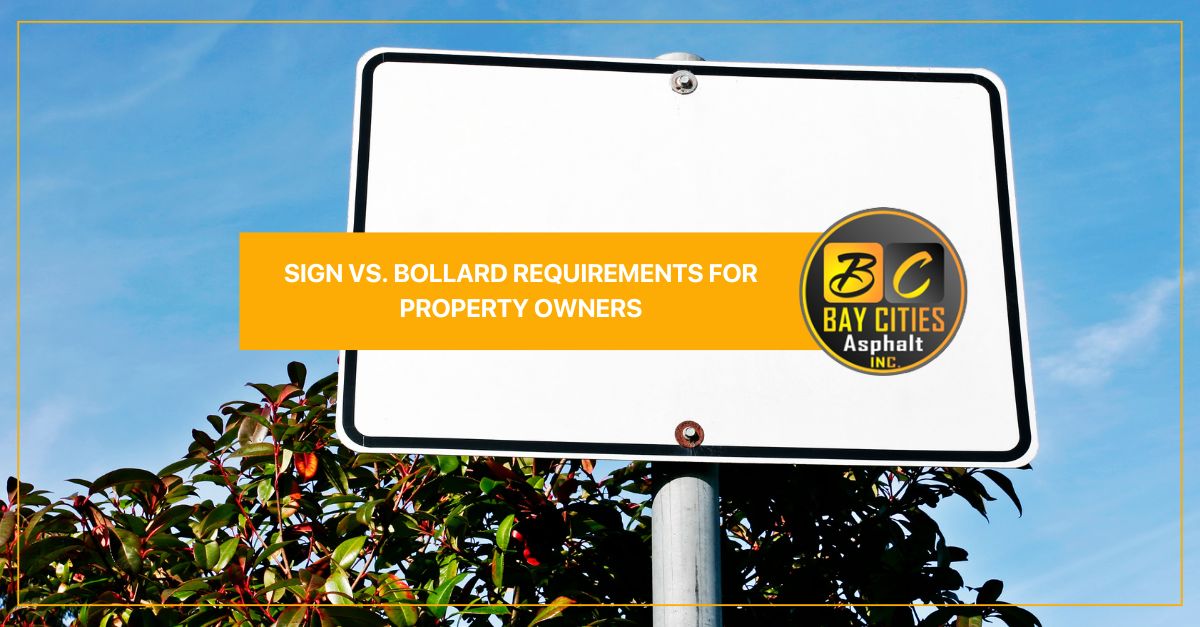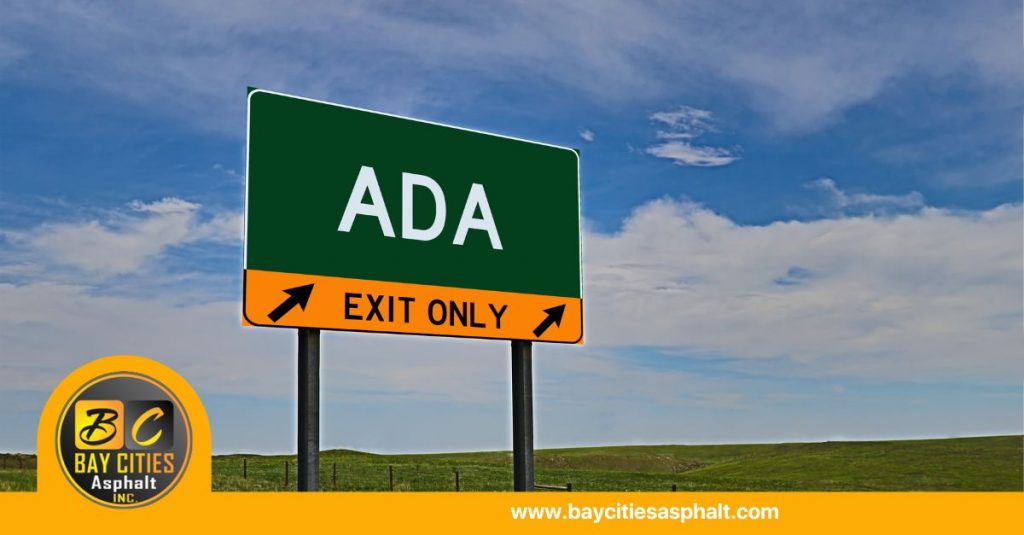
Maintaining a safe and accessible property is a top priority for any owner. While things like smooth pavement and clear markings are essential, understanding sign requirements and the role of bollards is equally important. Both serve critical functions, but they are governed by different sets of rules and regulations.
This guide will walk you through the key differences between sign and bollard requirements. Additionally, we will cover the primary regulations that govern each, ranging from the Americans with Disabilities Act (ADA) for signage to local building codes for bollard installation. As a result, by the end, you’ll have a much clearer understanding of what you need to do in order to keep your property safe, compliant, and well-managed.

What Are Signs and Bollards For?
Before we explore the specific regulations, it’s helpful to understand the distinct roles signs and bollards play on a commercial or residential property.
-
Signs are primarily for communication. They convey information, provide direction, and ensure accessibility. Understanding sign requirements helps ensure these signs meet legal standards while clearly guiding visitors around the property. Their main job is to inform people.
-
Bollards are physical barriers. Therefore, their primary purpose is safety and traffic control. These sturdy, vertical posts are installed to protect buildings from vehicle collisions, guide traffic flow, and prevent unauthorized vehicle access to pedestrian-only areas.
- As a result, these sturdy, vertical posts are installed to protect buildings from vehicle collisions, guide traffic flow, and prevent unauthorized vehicle access to pedestrian-only areas.
While both contribute to a property’s overall safety and functionality, their different purposes mean they fall under separate regulatory frameworks.
Key Regulations for Sign Installation
Signage on your property isn’t just a matter of design preference; it’s often legally mandated. The most significant set of rules comes from the Americans with Disabilities Act (ADA), which ensures that everyone, regardless of ability, can navigate your property.
Americans with Disabilities Act (ADA) Requirements
The ADA has specific guidelines for signs that are considered “architectural,” meaning signs that directly relate to, guide, or inform visitors about essential functional spaces. For example, this category includes room numbers, directional signs, and, most importantly, for property owners, parking signs.
To begin with, key ADA requirements for parking signs include:
- The International Symbol of Accessibility: All accessible parking spaces must be marked with the universally recognized wheelchair symbol.
- Mounting Height: Signs must be mounted so the bottom edge is at least 60 inches above the ground surface. This ensures that, regardless of vehicle height, they remain visible to both drivers and pedestrians.
- Location: The sign should be positioned at the head of the parking space.
- Van-Accessible Spaces: For van-accessible spots, additional signage indicating “van-accessible” is required.
Ultimately, failing to meet these standards can result in significant fines and, even more importantly, make your property inaccessible to a portion of the population.
Local Zoning and City Ordinances
Furthermore, beyond the ADA, local city and county governments have their own rules for signage. These ordinances can regulate a variety of factors:
- Size and Dimensions: Municipalities often have limits on how large signs can be.
- Placement: Rules might dictate how far a sign must be set back from the property line or street.
- Lighting: Some areas have restrictions on illuminated signs to prevent light pollution.
- Aesthetics: Historic districts or planned communities may have specific requirements for the style and materials of signs to maintain a consistent look.
Therefore, before any sign installation, it’s crucial to consult your local planning or zoning department to obtain the proper permit and ensure your plans comply with all applicable local rules.
Key Requirements for Bollard Installation
Unlike signs, bollards are regulated more as safety structures than informational tools. Their requirements are typically found in building codes, fire codes, and sometimes, specific state or federal security directives.
Protecting Pedestrians and Property
The primary function of most bollards is asset and pedestrian protection. They are installed to create a protective barrier around:
- Building Entrances: To prevent a vehicle from crashing through the front doors.
- Outdoor Seating Areas: Protecting diners at restaurants or cafes.
- Sensitive Utilities: Shielding gas meters, fire hydrants, or electrical boxes from vehicle impact.
- Pedestrian Walkways: Clearly separating foot traffic from vehicle traffic.
Local Building and Fire Codes
Your local building code is the main source for bollard installation requirements. These codes specify:
- Spacing: Bollards are typically required to be spaced no more than 5 feet apart to effectively block a standard-sized vehicle.
- Foundation Depth and Strength: To be effective, a bollard must be installed in a deep, concrete-reinforced foundation. A shallow installation will not withstand a vehicle’s impact. The exact depth and rebar requirements will be detailed in local codes.
- Material and Height: Codes may specify the material (e.g., steel), diameter, and height of the bollards to ensure they provide adequate protection.
Fire codes also play a role. Bollards cannot obstruct access for emergency vehicles. Fire lanes and access points to fire hydrants must be kept clear, and bollard placement must be planned accordingly.
Planning Your Next Property Update
Navigating the world of sign and bollard requirements can feel complex, but it doesn’t have to be. Working with a knowledgeable contractor who understands both ADA guidelines and local building codes is the best way to ensure your project is a success. A professional can help you develop a compliant plan, secure the necessary permits, and perform the installation correctly the first time.
At Bay Cities Asphalt, we have extensive experience with all aspects of property maintenance and safety, including professional sign and bollard installation. We can help you assess your property’s needs and ensure every element is up to code.
Ready to enhance the safety and accessibility of your property? Contact us today to discuss your project and get a free estimate
